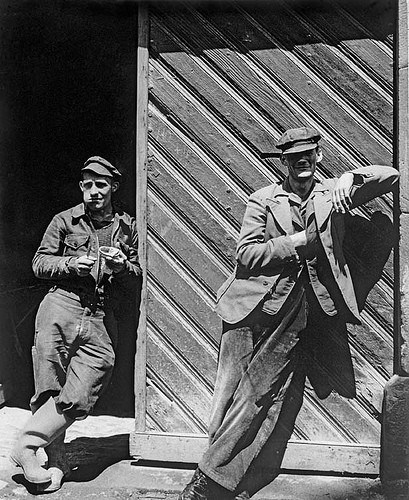A Hard, Merciless Light
06 Apr - 22 Aug 2011
A HARD, MERCILESS LIGHT
The Worker-Photography Movement, 1926-1939
Curator: Jorge Ribalta
6 April - 22 August, 2011
A Hard, Merciless Light. The Worker-Photography Movement, 1926-1939 examines the period during the history of 20th century photography in which photography joined forces with various worker movements (ranging from trade unionism to the creation of “workers' states” like the Soviet one), motivated by growing working-class consciousness and the idea of taking over the means of production and reproduction of images. By looking at the artistic avant-garde in its interconnection with the political avant-garde, this exhibition challenges hegemonic historiography that focuses primarily on other movements arising in the history of photography, such as the New Vision. The exhibition displaces the importance of mechanical vision and instead considers photography's relationship with social movements, shifting the debate toward photography as a document. It presents photographs (many of which are vintage copies), films and other documents, with special attention being paid to periodicals, the fundamental medium for the circulation of images and the ideas associated with them during these years.
A product of the Third Communist International (the first one to follow the Soviet Revolution), the movement finds its origin in the competition organised in 1926 by the magazine AIZ (Arbeiter Illustrierte Zeitung, or Workers' Pictorial Newspaper), in the context of the Weimar Republic. Simultaneously, in the Soviet Union, the magazine Sovetskoe Foto came to life, with the mission of leading and co-ordinating Soviet photographic culture in an effort to help build the new Socialist state. From these beginnings, worker photography would expand to the point of becoming paradigmatic for leftist movements in central and northern Europe and the United States; these ramifications would impregnate the experiences of the Popular Front in Spain and France, two case studies that underline the transnational nature of the movement. Around 1939, with the end of the Spanish Civil War and the beginning of World War II, a new world order would begin, leading to the decline of a movement that had produced such names as Sergei Tretyakov, David Seymour, Robert Capa, Paul Strand, Tina Modotti, Walter Ballhause or Max Alpert, among many others.
If the various workers' revolutions proposed new visions of the world and radical methods for re-educating our way of seeing, worker photography was born of this same social consciousness, which led to the appropriation of the photographic medium and, therefore, of the image itself. This exhibition paints a fresco of the moment in which self-representation by the working class became a form of social emancipation, offering a look across to, not down at, the working class during the central years of the first half of the 20th century. The items displayed and the corresponding catalogue create a whole that explains a fundamental chapter in the historiography of photography. In parallel, the film series Proletarian Documentary analyses the emergence of the audiovisual document which, along with the photographic document, constitutes the beginning of modern visual culture.
The Worker-Photography Movement, 1926-1939
Curator: Jorge Ribalta
6 April - 22 August, 2011
A Hard, Merciless Light. The Worker-Photography Movement, 1926-1939 examines the period during the history of 20th century photography in which photography joined forces with various worker movements (ranging from trade unionism to the creation of “workers' states” like the Soviet one), motivated by growing working-class consciousness and the idea of taking over the means of production and reproduction of images. By looking at the artistic avant-garde in its interconnection with the political avant-garde, this exhibition challenges hegemonic historiography that focuses primarily on other movements arising in the history of photography, such as the New Vision. The exhibition displaces the importance of mechanical vision and instead considers photography's relationship with social movements, shifting the debate toward photography as a document. It presents photographs (many of which are vintage copies), films and other documents, with special attention being paid to periodicals, the fundamental medium for the circulation of images and the ideas associated with them during these years.
A product of the Third Communist International (the first one to follow the Soviet Revolution), the movement finds its origin in the competition organised in 1926 by the magazine AIZ (Arbeiter Illustrierte Zeitung, or Workers' Pictorial Newspaper), in the context of the Weimar Republic. Simultaneously, in the Soviet Union, the magazine Sovetskoe Foto came to life, with the mission of leading and co-ordinating Soviet photographic culture in an effort to help build the new Socialist state. From these beginnings, worker photography would expand to the point of becoming paradigmatic for leftist movements in central and northern Europe and the United States; these ramifications would impregnate the experiences of the Popular Front in Spain and France, two case studies that underline the transnational nature of the movement. Around 1939, with the end of the Spanish Civil War and the beginning of World War II, a new world order would begin, leading to the decline of a movement that had produced such names as Sergei Tretyakov, David Seymour, Robert Capa, Paul Strand, Tina Modotti, Walter Ballhause or Max Alpert, among many others.
If the various workers' revolutions proposed new visions of the world and radical methods for re-educating our way of seeing, worker photography was born of this same social consciousness, which led to the appropriation of the photographic medium and, therefore, of the image itself. This exhibition paints a fresco of the moment in which self-representation by the working class became a form of social emancipation, offering a look across to, not down at, the working class during the central years of the first half of the 20th century. The items displayed and the corresponding catalogue create a whole that explains a fundamental chapter in the historiography of photography. In parallel, the film series Proletarian Documentary analyses the emergence of the audiovisual document which, along with the photographic document, constitutes the beginning of modern visual culture.

